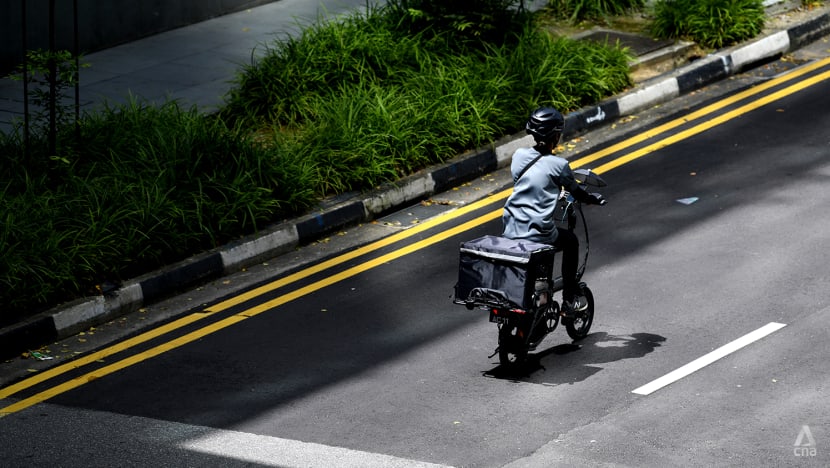'Give you money, you don’t want?': 3 in 4 older platform workers yet to opt in for higher CPF contributions
Those who have yet to opt in are likely adopting a "wait and see" attitude, a researcher says.

A food delivery rider seen in Singapore's central business district on Jan 14, 2022. (Photo: CNA/Calvin Oh)

This audio is generated by an AI tool.
SINGAPORE: Private-hire driver Lincoln Khoo chose to take up the higher Central Provident Fund (CPF) contributions for platform workers “because CPF is also my money, so might as well opt in to get more income”.
After opting in, the 40-year-old is entitled to receive CPF contributions from the platform operators he works with – in this case, Gojek and Tada.
Mr Khoo, who drives part-time and also works as an emcee and financial service consultant, earns about S$1,000 (US$780.50) from completing 50 trips a month. Reduced take-home earnings from higher CPF contributions has “never been an issue” for him as he has other jobs, he said.
But he is among a minority of older platform workers born before Jan 1, 1995, who are given a choice of whether to increase their CPF contributions to eventually match that of regular workers by 2029.
As of April, a quarter of older platform workers have opted to increase their CPF contribution rates, a CPF Board spokesperson said in response to CNA's queries on the scheme's take-up rates.
The move to gradually align platform workers’ CPF contribution rates with that of salaried employees kicked in at the start of 2025.
The move is part of the Platform Workers Act, a suite of stronger employment protections for gig workers that was passed in September last year.
The measure is intended to improve the retirement and housing adequacy of platform workers, who largely work as private-hire vehicle drivers, delivery workers, as well as taxi drivers who use ride-hailing platforms.
Those who do not opt in for higher CPF contributions only make MediSave contributions, and do not receive contributions from the platform operator.
Those who opt in will contribute to MediSave and the Ordinary and Special Accounts. They also get contributions from the platform operator.
Between January and April, around 105,700 platform workers received CPF contributions from platform work in at least one of the months.
Out of this number, 88,200 platform workers were born before 1995 and are turning 31 or older this year. Higher CPF contributions are not mandatory for this cohort.
Of these, 22,400 platform workers or 25 per cent opted in for higher contributions, the CPF Board spokesperson said.
This is three times the number of platform workers who had opted in as of December 2024, the spokesperson said.
The opt-in rate is a higher 30 per cent when considering those who worked consistently every month from January to April.
“Platform work is transient in nature, and some may only take on platform work sporadically,” said the spokesperson.
“These trends suggest that platform workers who rely more consistently on platform work recognise the value of CPF contributions.
“We encourage other platform workers who have not opted in to consider doing so, so they can also benefit from the higher CPF contributions.”
Higher CPF contributions are mandatory for platform workers born on or after Jan 1, 1995, who are turning 30 or younger this year.
There are 17,500 platform workers in this younger cohort, according to the CPF Board.
In the past three years, the number of regular platform workers has fallen from 88,400 in 2022, to 70,500 in 2023, to 67,600 last year, according to Manpower Ministry data.
The ministry previously noted a general rise in the number of regular resident platform workers from 2016, except for a “choppier” period during the COVID-19 pandemic.
WHAT PLATFORM WORKERS SAY
For those who opt in to make higher CPF contributions, platform operators will have to make CPF contributions to the worker at a rate of 3.5 per cent of their net earnings in 2025.
The rate that platform operators contribute will rise gradually until it reaches up to 17 per cent by 2029, which is the same level that regular employees can currently receive from their employers.
At the same time, platform workers who opt in also make their own CPF contributions, which will rise to up to 20 per cent by 2029.
Over the years, CNA reported that platform workers were worried about the lower take-home earnings if they had to contribute to their CPF.
These concerns have not changed among those CNA spoke to over the past week, who are born before 1995 but are still relatively young.
Those who did not opt in said they wanted to maximise their take-home earnings, or felt that the amount they could gain was negligible.
One of them was Mr Zulkifli Othman, 42, who started working as a Foodpanda delivery rider in 2019. Before that, he was a private-hire driver and taxi driver.
“I need more cash to offset the day-to-day living costs,” said the father of four, who earned S$300 to S$350 a week as a full-time delivery rider.
As a platform worker with unstable income, retirement savings were secondary to meeting his family’s daily needs.
In July, Mr Zulkifli switched from delivery work to a job in a factory as he wanted more stability to look after his children aged four to 12, for whom he is the main caregiver.
Then, there is Mr John Lau, 40, who does private-hire driving for various platforms four nights a week, after his full-time job as a safety officer. He, too, did not opt in because of the impact on his daily earnings.
He makes about 120 trips a month, earning S$2,000 to S$2,500 before deductions. He uses the earnings to pay for his car instalments, road tax, insurance and parking, with some cash to spare.
Based on the number of monthly trips he does, it is “not viable” to opt in for higher CPF contributions as the amount he would gain is “insignificant”. His full-time job already helps him build up his CPF, he said.
A Grab delivery rider who only wanted to be known as Mr Lee, 43, opted in for higher CPF contributions when it was announced, but has since come to regret it.
He noted that those who opt in cannot later decide to opt out. There is no deadline to opt in and workers can do so at any time.
Mr Lee said the low initial CPF contribution rate of 3.5 per cent from platform operators made opting in not worth it, and that it would be better if this started at a higher rate.
He also felt that as “most of the CPF contribution is going to MediSave”, this did not necessarily benefit his retirement savings.
The contribution rate to MediSave remains the same whether platform workers opt in to higher CPF contributions or not.
In 2025, the first year of implementation, this is reflected by a higher proportion of CPF contributions being allocated to MediSave than the Ordinary and Special Accounts, for platform workers of all ages.
These ratios will gradually adjust so that by 2029, younger workers are contributing more to their Ordinary Accounts, while older workers are putting more into their MediSave and Retirement Accounts, similar to salaried employees.
Lower-income platform workers who earn S$3,000 or less a month and pay higher CPF contributions can receive monthly cash payments to offset the increase through the Platform Workers CPF Transition Support scheme.
From March to June, 16,500 platform workers benefited from this support, which is based on CPF contributions made from January to April.
The support scheme will taper off after 2028.
UNIONS ON DISCRIMINATION AND COST CONCERNS
Ms Yeo Wan Ling, assistant secretary-general of the National Trades Union Congress, said platform workers generally understand the benefits of CPF, but have concerns about the nature of platform work and how it relates to CPF calculation.
"Platform earnings change with dynamic fares and incentive schemes. Our drivers and riders worry that higher CPF contributions will reduce their daily earnings," she said. "Some are afraid they will get fewer jobs if they opt in because they will cost more to platform operators."
Some also worry that the cost of CPF contributions is fully passed on to drivers and riders, said Ms Yeo, who is an adviser to the National Delivery Champions Association, National Taxi Association and National Private Hire Vehicles Association.
These associations have been organising workshops to educate platform workers about the benefits of CPF and work closely with the CPF Board to get direct advice to workers, she said.
Tripartite partners have assured workers that platforms cannot discriminate against those who opt in, Ms Yeo added. The unions have also helped rectify issues such as miscalculated or delayed contributions and continue to advocate for earnings transparency.
EMPLOYER CONTRIBUTIONS ARE PART OF INCOME
To economist Walter Theseira, not opting in lowers the “effective wages” of the worker because they will not receive the platform operator’s CPF contributions.
“I think we all know how hard it is to get a wage boost of 17 per cent, and this is money that platform workers could get if they opted in,” he said, referring to the highest rate of platform operator contributions.
A worker who intends to purchase a home in the future will probably be “worse off” as CPF contributions to the Ordinary Account can be used for that purpose, pointed out the associate professor at the Singapore University of Social Sciences.
“Their net take-home cash position would be little changed, and they would be getting additional top-ups to their retirement and MediSave, on top of that,” he said.
Assoc Prof Theseira added that those who are considering a home purchase need to see if their plans are “realistically achievable” without the higher CPF contributions.
“For many Singaporeans, it would be difficult to accumulate enough money for the housing downpayments without CPF, and this is especially so for platform workers who are lower-income,” he said.
Providing customised examples could help to make the choice of opting in or not more relevant to workers, such as a toolkit for those paying for or planning to buy a house, or showing workers how much they would receive in CPF payouts after retirement, he suggested.
Mr Shamil Zainuddin, who is studying platform work as a PhD student at the University of California, San Diego, said the most common reason he has heard for opting in is that the platform operator will also contribute to CPF.
“As one worker puts it: ‘People give you money, you don’t want ah?’ Even if the starting amount is 3.5 per cent, it is still additional CPF savings that wouldn’t otherwise exist, and the rate will increase in the coming years.
“Highlighting this ‘extra money from the platform’ narrative and making benefits tangible can give workers the clarity they need to decide whether it suits their life stage and goals,” he said.
Mr Shamil also said that the priority should be to help platform workers make an informed choice as the decision to opt in is irreversible.
“Workers understand the general benefits of CPF, but they are likely adopting a ‘wait and see’ attitude. They want to observe how opting in plays out for fellow workers.
“It would help to share honest reviews from older platform workers who have opted in, explaining how it has affected things like take-home pay and working hours.”
He added that workers should not feel pressured into making a choice as “if they later experience unexpected downsides, they may feel misled and hold the authorities responsible for not presenting a complete and realistic picture from the outset”.

















